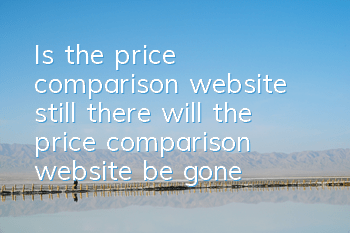The price comparison platform has disappeared, and it is difficult to support the "buy slowly" alone
As online shopping is integrated into all aspects of our lives, various markets of joint demand generated by online shopping have also been emerging over the years.
For example, when major e-commerce websites become more and more productive and promotional activities are becoming more and more common, consumers are often trapped in massive discount information and cannot extricate themselves. Especially as product price factors become the core element of consumers' choice of goods, people often want to know which platform has lower prices and what time period the product has the best price discount, which has led to the emergence of price comparison platforms.
Especially when the e-commerce market supervision environment was not as mature as it is now, various price comparison platforms and price comparison plug-ins have become essential tools for consumers to shop online. There was no way. At that time, the price chaos on various e-commerce platforms was too common. As long as consumers did not want to be "cut" in, they were potential users of the price comparison platform.
However, in recent years, as e-commerce platforms become more standardized and mature, relevant supervision is becoming stronger and stronger, and the diversification of various promotional activities of e-commerce platforms themselves, price comparison platforms are gradually disappearing from our sight. Among the many price comparison platforms, only platforms like "Buy slowly" still have some influence.
So, can you find your own way out in the industry environment where the price comparison website has disappeared? Can it make e-commerce price comparisons in the country a business worth betting on?
Buy APP slowly, and still stick to price comparison
According to the official introduction, Guru Bu was established in July 2010. After more than ten years of development, it has developed from a simple price comparison tool and a historical price query assistant to "a neutral product search recommendation engine".
At the data level, as of the first half of this year, Slow Buy has pushed discount information to more than 20 million users, with annual searches exceeding 700 million times, covering 250 million coupon products.
It can be seen that for the current slow buying, it is still sticking to its own understanding of e-commerce price comparison, and using price comparison as the core user traffic entrance.
But in addition, it may be because the price comparison industry has proven to have no market in recent years, it is packaging new concepts such as price comparison shopping guide platforms across the entire network, neutral product search recommendation engines, and product data analysis platforms.
Unfortunately, due to limited influence and the overall environment of the e-commerce industry can no longer support the rapid development of the price comparison platform, these new concepts of buying slowly do not seem to have caused much storm in the market. When people mention it, their first impression is still that e-commerce price comparison platform.
From the perspective of various publicity positioning and the actual functions provided by APPs and websites, buying slowly has indeed not left the price comparison platformcategory.
Among the various introductions about buying slowly online, "all-network price comparison" and "find the lowest price" are the core tags. Buying slowly is a "price comparison tool" for online shopping, "so that consumers can buy cost-effective products without spending money."
In terms of specific services, the APP of Slowly Buy APP brings together some special products from major e-commerce platforms across the network, including food, clothing, cosmetics, digital electronics, home life, etc. This kind of operation can help price-sensitive consumers to select the low-priced goods they want on the platform, avoiding the hassle of comparing and choosing on multiple platforms.
In addition, Slow Buy Development has shopping decision-making assistants such as price comparison on the entire network and historical price inquiry. These tools can help consumers achieve direct monitoring of product prices across the network, so as to save more worry and trouble when purchasing products.
The mode may be outdated, where is the future?
It should be pointed out that price comparison platforms like Buy Slowly are indeed popular many years ago. However, in recent years, few people in China have used various price comparison platforms and tools. The price comparison model has been abandoned by many entrepreneurs, and the remaining platforms like Slowly Buy have a very low presence in the e-commerce industry.
Why is price comparison no longer popular?
Around 2010, it was the time node for the great development of the domestic e-commerce industry. At that time, various e-commerce platforms such as Taobao, JD.com, Amazon, No. 1 Store, Suning.com, Dangdang.com, etc. had a certain influence, and they may also have their own advantages in certain product categories.
So, in order to more conveniently know which platform sells lower in specific products, a price comparison platform came into being.
But now, as e-commerce traffic gradually concentrates on the head and fewer choices, the meaning of price comparison is getting smaller and smaller. Anyway, the products are basically on Tmall and JD.com. If you want to have a cost-effectiveness and don’t consider the service, you can go to Pinduoduo, and there are not many platforms that need to consider.
In addition, there are more technical and industry reasons why price comparisons are no longer popular.
Before 2015, domestic e-commerce traffic was still concentrated on PC sites. At that time, all e-commerce platforms were also promoting PC sites. Correspondingly, the price comparison platform could also conveniently capture product data from PC sites.
But after 2015, mobile e-commerce became popular, and even emerging e-commerce, such as Pinduoduo and live e-commerce, did not have PC sites at all, which made it increasingly difficult for price comparison platforms to achieve real-world price comparison.
Also, e-commerce platforms have long learned "fine". When using the price comparison platform, we often find that the lowest price we see is often not the lowest price. The reason is that in order to increase attention, e-commerce merchants will specially configure a so-called lowest price on the page, but the mostThe low price may be just a small quantity or experience equipment, which further makes the so-called price comparison across the entire network lose the "standard".
Considering that the various promotional activities on e-commerce platforms are becoming more and more diverse, under various pre-orders, flash sale, flash sale, and coupon gameplay, the price changes and preferential promotions of products can be said to be very complicated, and the prices of products captured by the price comparison platform are naturally very complicated. In addition, e-commerce platforms are often not willing to let the price comparison platform easily capture their real prices, so the soil for price comparison platforms to survive is getting worse and worse.
The last is the survival and business model of the price comparison platform.
As we all know, although price comparison is good, this service cannot be provided in vain. The platform needs to find a profit model that can help them make money. However, judging from the development of many price comparison platforms in the past, the relatively reliable way they can find profits can only be achieved through user traffic diversion after price comparison, and find corresponding e-commerce platforms to get rebates.
This has forced many price comparison platforms to slowly transform into rebate platforms. More importantly, since price comparison platforms need to rely on e-commerce platforms to "eat" them, the centrality will face the doubts of "untenable".
A variety of reasons have led to the decline of the price comparison platform. Although it is still trying to be active when buying such a platform, considering that its core business model is still focusing on the entire network price comparison ten years ago, we think it is difficult for it to continue to develop this falsified business model.
In the era of mobile Internet, the original intention of price comparison may be good, but it lacks the soil for survival and growth. For survivors or persistents who slowly buy such price comparisons, they must find their future direction of transformation.









